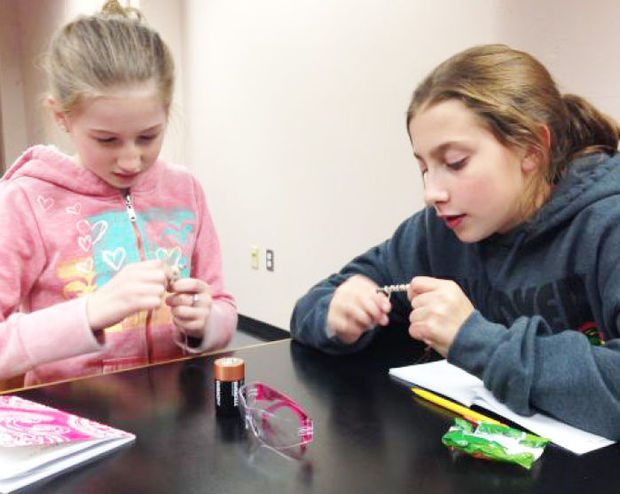By Renata Birkenbuel
The Montana Standard, Butte
Pack a few dozen girls and women in a science lab and the possibilities for invention are endless.
A new all-girls after-school science club, Girls Excelling in Math and Science, is a big draw because members conduct experiments, study famous women scientists and relax as they learn the periodic table.
Between 17 and 21 kids have shown up at any one time, packing the classroom.
Open to all girls in grades 5 through 8, GEMS instructors guide the kids in making electronic magnets, devising home-made hovercrafts, programming 3D printer boxes and giving a one-minute elevator speech describing themselves.
“I think it’s a fun way for the girls in town to connect with one another,” said Ella Prigge, 11, a Whittier sixth grader.
“We can learn new experiments that we can do at home,” added Haley Johnson, 12, a Margaret Leary sixth grader.
Ronda Coguill, director and club co-founder, teaches the scientific method: the power of observation and recording those observations in a notebook — standard process of a working scientist.
“We teach scientific terminology and the observation method versus the perception method,” said Coguill. “For some experiments, they will actually gather data.”
Coguill is a senior scientist materials specialist with CAMP — the Center for Advanced Mineral and Metallurgical Processing at Montana Tech, where the club meets weekly in the basement of the Engineering Lab Classroom.
The college donates the space and Coguill donates her expertise, as does co-found Pam Haxby-Cote of Blackstone Launch Pad and Headwaters RC&D.
“Having the infrastructure and expertise at our fingertips is pivotal to the success we are having,” said Coguill. “I have done a lot of teaching activities with kids of all ages. Hosting them on a campus is by far the most complete way to provide the entire gamut of information and activities needed to fulfill these sorts of endeavors.”
Sarah Borduin, a registered nurse, is a big fan of GEMS since her two daughters thrive in the club.
“It’s just so inspiring that girls can go and learn about real science from people who do science for a living,” Borduin said.
Role models play a role as hands-on mentors, too.
Jill Benson, 25, earned degrees in studio arts and arts history at Montana State University, but as Headwaters fiscal officer, she melds the disciplines as a GEMS mentor.
“I want to combine the humanities with science,” said Benson, Coguill’s daughter. “There doesn’t need to be such a divide between artists and scientists.”
Benson’s younger sister, Libby Coguill, 20, mentors the youngsters, too. She is an environmental engineering major at Tech.
“I flick all over the room and help the girls with experiments,” said Libby.
Even Kirstie McPherson, president of the Associated Students of Montana Tech, takes time to be a mentor.
Borduin’s daughters Vivian, 10, and Lydia, 9, are students at Kennedy Elementary, where fifth- and sixth-grade teachers are gearing up for the annual science project after the New Year.
In a unique partnership, GEMS instructors and mentors will hook up with Kennedy teachers in January to double-team students on their science projects, due in time for the Feb. 18 school science fair.
“Ours is for fun and extra, but the girls can use the same science experiment for school,” said Ronda Coguill, who will give lab demonstrations to Kennedy students at Tech on Dec. 16.
“We are absolutely thrilled that our students will be able to participate in the Science Club here at Kennedy,” said Mary Spangler, Kennedy fifth-grade science teacher. “Our students will benefit tremendously. Some students’ parents are not able to help their children at home with this project — they will especially benefit from this program.”
Coguill and Haxby-Cote are impressed with the diversity they’ve attracted: kids of all income levels, cross-town girls who would never otherwise meet and home-schooled kids who may widen their horizons.
All-girl classrooms have advantages, as studies have proven. Girls tend to work well as collaborators, gain self-assurance from immediate feedback in math and science and can relax better than in mixed-gender classes or clubs.
“Girls start to feel confident about math and science,” added Sarah Borduin. “GEMS helps them gain a healthy interest and then maybe they’ll pick those majors in college. Seeing women who have done that is very important for the girls.”
Girls who strive to be first-generation college graduates gain exposure to college labs and classrooms.
“The folks in the building look forward to seeing the girls in the department and hearing the reports of the fun experiments we have completed each week,” added Ronda Coguill. “The GEMS are definitely a bright spot in our weekly work activities.”
After the first of the year, instructors and mentors will continue to focus on math and science concepts — and listen to what the members want to learn.
“The club is cool and I like how creative we can get,” said Korinne Treser, a 7th-grader who’s home-schooled. “I probably never would have thought about most of this stuff.”














































































































































































































































































































































































